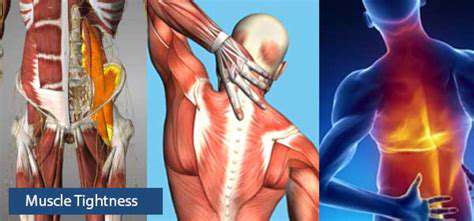Common Causes of Muscle Tightness and Effective Relief Strategies
Identifying the Causes of Muscle Tightness

Physical Activity and Overuse
One of the primary causes of muscle tightness is physical activity, especially when it involves repetitive motions or heavy lifting. Muscles can become fatigued and tight as they struggle to recover during periods of intense exercise. This is particularly common in athletes and individuals who suddenly increase their activity levels.
Overuse can lead to micro-tears in muscle fibers, necessitating rest and recovery. It's vital to recognize when you're pushing your body too hard to prevent chronic tightness and injuries. Engaging in proper warm-up and cool-down routines can significantly mitigate these effects.
Incorporating rest days into your exercise regimen allows muscles to repair themselves, promoting better flexibility and reducing the risk of tightness. If tightness persists despite adequate rest, it may be time to evaluate your training program.
Poor Posture and Ergonomics
Poor posture can greatly contribute to muscle tightness, especially in the neck, shoulders, and back. Extended periods of sitting or standing in improper positions can lead to muscle imbalances and chronic tightness. This is increasingly common with the rise of sedentary lifestyles and remote work setups.
Ergonomics plays a crucial role in maintaining muscle health. Adjusting your workspace to promote proper posture and taking frequent breaks can help alleviate tension build-up in the muscles. Simple changes, like using an adjustable chair or standing desk, can make a significant impact.
Moreover, being mindful of your posture throughout daily activities—such as texting or driving—can reduce strain on muscles. Regularly practicing good posture habits can contribute to long-term muscle relaxation and comfort.
Stress and Mental Health
Emotional stress is another significant factor that can lead to muscle tightness. The body often responds to stress by tensing muscles, particularly in the neck and shoulders. Chronic stress can result in persistent tightness, leading to discomfort and pain. Recognizing the link between mental health and physical muscle tension is crucial for effective relief.
Incorporating stress-reducing techniques, such as mindfulness or meditation, can greatly alleviate muscle tightness. Engaging in relaxing activities allows the body to release tension and promote a sense of well-being. Yoga and deep breathing exercises are especially beneficial.
Additionally, seeking professional help from a mental health provider can provide strategies for managing stress effectively. Lessened stress can translate to reduced muscle tightness and overall physical health improvement.
Dehydration and Nutritional Deficiencies
Muscle tightness may also result from dehydration and a lack of essential nutrients. Lack of adequate hydration affects muscle function, leading to cramping and tightness. Electrolyte imbalances caused by insufficient fluid intake can exacerbate these issues. Maintaining proper hydration levels is critical for muscle health.
A balanced diet rich in vitamins and minerals helps support muscle function. Nutrients like magnesium and calcium play vital roles in muscle contraction and relaxation. Ensuring you're consuming a varied diet can prevent cramps and tightness.
If muscle tightness is frequently experienced despite proper hydration and nutrition, consulting a healthcare professional may be necessary to identify specific dietary deficiencies or other underlying issues that need addressing.
Injuries and Underlying Medical Conditions
Muscle injuries or strains can lead to tightness as the body tries to protect the affected area. Injuries can cause inflammation, leading to a decrease in flexibility and an increase in tightness. Chronic injuries can create a cycle of discomfort that may require professional intervention.
Underlying medical conditions, such as fibromyalgia or arthritis, can also contribute to muscle tightness. These conditions often involve systemic inflammation and pain that affect mobility and comfort. Early diagnosis and appropriate treatment are crucial for managing symptoms effectively.
Incorporating physical therapy and regular check-ups can aid in recovery and help prevent future tightness. Monitoring your body's response to certain activities and adjusting accordingly can also protect against long-term complications.
Strategies for Relief and Prevention

Identifying the Roots of Muscle Tightness
Muscle tightness can often be attributed to several common factors, including prolonged sitting or standing, lack of physical activity, and overexertion during exercise. Understanding these causes is essential for effectively managing and preventing discomfort. When muscles are not used regularly, they can become stiff, making it important to incorporate movement into daily routines.
Stress and tension can also play a significant role in muscle tightness. When the body experiences stress, it often responds by tightening certain muscle groups, particularly in the neck, shoulders, and back. Being aware of your stress levels can help you identify patterns that lead to muscle tightness.
Injuries or medical conditions such as arthritis can contribute to muscle stiffness as well. In such cases, it's crucial to seek professional guidance for tailored strategies to alleviate and manage the tightness effectively.
Effective Relief Techniques and Prevention Strategies
Incorporating regular stretching into your routine can greatly enhance muscle flexibility and reduce tightness. Techniques such as yoga or simple stretching exercises can help release tension and restore balance to your muscles. Consistency is key; aim to stretch regularly to see long-term benefits.
Another effective strategy is to engage in low-impact exercise like walking, swimming, or cycling. These activities can improve circulation and promote blood flow to tight muscles, aiding in relief and recovery. It’s important to start slow and gradually increase the intensity to prevent further strain.
Finally, relaxation techniques such as deep breathing, meditation, or massage therapy can significantly help in managing muscle tightness by reducing stress. Regularly scheduling time for self-care can create a holistic approach to preventing future issues, helping keep your muscles relaxed and functioning optimally.



